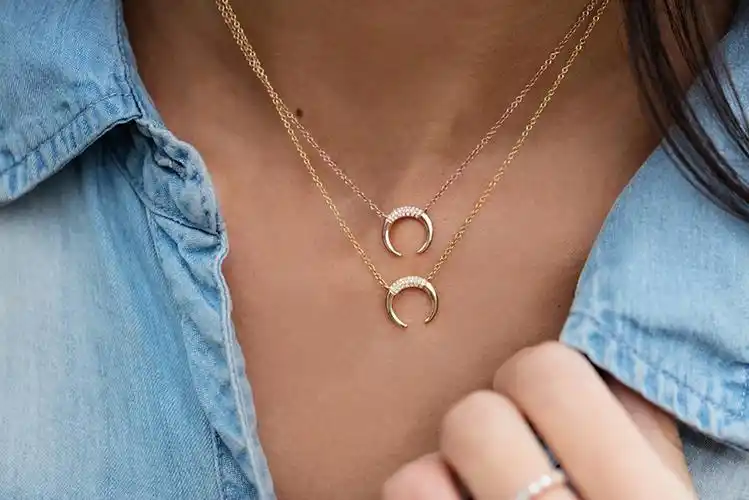14k, 18k, or 24k: Which Gold Should You Choose?
Which Karat is Better? 24k, 18k, or 14k Gold? Deciding between 24k, 18k, or 14k gold can significantly impact your gold jewelry choice. Both the Karat value of gold and the properties of the impurities it contains impact the final look and practical uses of the precious metal. In this article, we present the differences between 24k, 18k, and 14k gold jewelry to guide you toward your future purchase.

What is 24k 18k, and 14k Gold?
Karat is a measurement used to quantify the purity of gold. For example, pure gold is 24k or 99.9% pure gold. 18k gold stands for 75% gold and 14k gold is an alloy containing 58.3% gold combined with other metals used in production. The differences mentioned above influence the appearance and strength of gold and provide the customer with insight into the proper use of gold jewelry.
24k Gold: The Luxury and Softness of Pure Gold
24k gold is the purest of all the types of gold. It retains almost 100% gold, which gives its deep yellow color when presented as jewelry. However, the high percentage of gold comes with a downfall – its softness. 24k gold can easily bend, scratch and deform, making it impossible to wear every day without loss of shape. Therefore, gold with 24 karats of purity is used to produce ceremonial items because it is not designed for regular use.
Pros of 24k Gold:
- Gold with 24k depth of color that acts luxury.
- Cultural and symbolic value because of the high purity price.
Cons of 24k Gold:
- Gold being easily bent, scratched, and deformed.
- Only suitable for items that will not be worn every day.
- Highest price among the three compared due to the price of production.
18k Gold: The Perfect Balance
18k — 75% pure gold, with the rest being some other metal like copper or silver This alloy make it more durable than 24k gold but maintains the large amount of real gold so that color is not diluted like lesser higher karat Alloys. And, this is why so many people consider 18k gold the perfect combination of ultimate luxury with everyday wearability — and for good reason too! This is a good option for gold jewelry such as rings, chains and bracelets, which are worn every day.
Pros of 18k Gold:
- Nearly 24k, though more durable but not as long lasting.
- Luxurious looking, great for everyday wear.
- Well-known among luxurious gold-made jewelry.
Cons of 18k Gold:
- Softer than 14k gold, it may be prone to damage under heavy wear.
- More expensive than 14k gold.
14k Gold (Average price and sturdy)
14k is made from a 58.3% of pure gold and other type exceptions or similar materials; Making it the hardiest of them all, which is perfect for everyday wear. Although the color of 14k gold is slightly paler than that of an 18 or 24 karat piece, it still has a warm golden hue and its lower balance makes it less expensive. 14k gold is the white metal of choice for engagement rings, wedding bands and other jewelry that you will wear everyday.
Pros of 14k Gold:
- Highly strong, perfect for use on a daily basis.
- Cheaper compared to 18k and 24 gold.
- Three layer color resistent to scratch and wear.
Cons of 14k Gold:
- 18k and 24 Colors Are Less Rich Than Gold
- Has a greater volume of metals, with less pure gold for those who are in search of 24k.
Which Karat Do You Want to Go With?
Shop Gold Rings 24k, 18k and 14k life style preference budget shop now
1.Everyday Use: When you want a piece of gold jewelry for everyday use such as wedding ring, bracelet 14 karats is the way to go — it offers superb strength and quality at an affordable price.
2.If you occasionally wear it, then for special events: 18k gold transcends beauty into a more luxurious option.
3.Ceremonial or cultural use: 24K gold is the usual gold to buy if you are using it for symbolic purposes, Many people file their pride in purchasing pure money which has a deep meaning but lacks strength relative to other type of Gold.
Then Why Aren’t 24k Gold Being Used Jewelry?
24k gold because it is too soft 500 Gold Plated (30 times heavier than jewelry with low ISO) It is prone to bending, scratching or deforming when it assistsantry in normal use. While it is valued greatly for its purity and frequently used in traditional or cultural jewelry, this attribute also makes if an impractical option for daily wear scheduled items. For this reason, much gold jewelry is composed of 18k or higher karat-gold and only widely distributed in such carats for superior durability coupled with the desired attractiveness of 24k gold.
Caring for Gold Jewelry
Regardless of the type, how you treat your gold jewelry will determine its longevity. Wash your gold jewelry with warm soapy water and a soft cloth, then store in a soft pouch or jewelry box to avoid scratches. Never let your gold pieces be in contact with harsh chemicals or getting scratched.
Conclusion
When it comes to gold, there are certain benefits associated with different components of its purity in terms of jewelry specs. 24k gold is the most pure, but also softest and least durable for daily use. 18K gold: offers beauty and is an ideal compromise between hardness and looks. 14 Karat Gold (aka 585): this is our most demanded alternative for, on the heavier side we can bring to you right now. By knowing these differences you can choose the best option for your gold jewelry needs, no matter what precious it may hold, play or class.